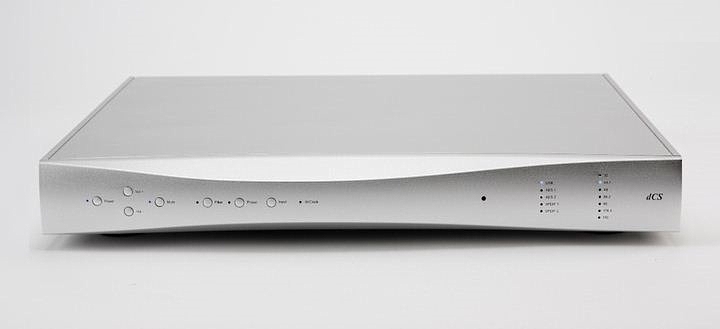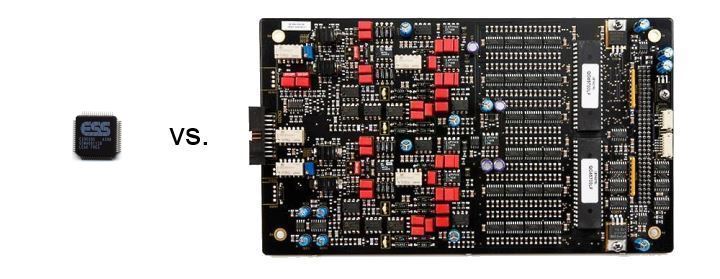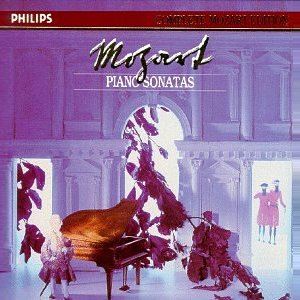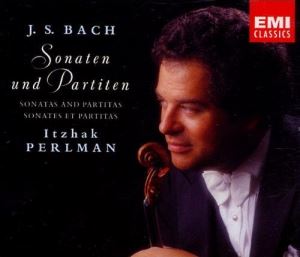Two products generated the lion’s share of the buzz at RMAF 2012: the Wilson Alexia loudspeaker ($48,500/pair) and the dCS Vivaldi four-box digital playback system comprised of the Vivaldi Transport, DAC, Upsampler and Word Clock (together, $108,500). Perhaps not coincidentally, they were available for audition in the same room, and the crowds were stretched down the hall as audiophiles waited eagerly in line to hear them. I have already reviewed the Wilson Alexia loudspeaker here. Now it’s time to consider something from dCS.
If the price tag of the Vivaldi system throws your heart into arrhythmia, and you are looking to update your existing CD player with an external DAC to play back your extensive collection of CDs, or you have moved beyond the shiny silver disc and committed your music collection to hard disk, or both, the Vivaldi DAC itself ($34,999) is one alternative. Still having palpitations? Consider instead dCS’s “entry level” DAC - the dCS Debussy ($11,499), which is the subject of this review.
The dCS Debussy DAC is housed in a sleek and curvy aluminum enclosure 17.6″ wide by 2.6″ high by 15.5” deep, weighing in at a surprisingly hefty 19.4 pounds. While elegantly designed, it is massively solid, inspiring immediate confidence. The left side of the front panel is adorned with six micro-switches for power/standby, volume, mute, digital filter selection, phase and input. Each button, except for volume and input is flanked by an LED to indicate its status. On the right side, two columns of LEDs indicate input selection and sample rate. The filter switch selects between a linear phase filter and a minimum phase (apodising) filter. There is an additional LED to indicate whether an external clock is connected, and an IR receiver lens. All front panel controls can be accessed through a rubberized aluminum remote that doubles as a bludgeon should the need arise.
The rear panel is busy but logically laid out. There are two AES/EBU inputs, two S/PDIF inputs – one coaxial and one BNC – and an asynchronous USB input. The AES/EBU and S/PDIF inputs accept word lengths up to 24-bit and sampling rates up to 192kHz. The USB also accepts up to 192/24 and, with a newly released firmware update, standard DSD over PCM. One input that is missing is Toslink, but since it is the red-headed step-child of digital inputs, few will notice its absence. There is an additional BNC input for use with an external word clock. Both balanced and unbalanced analog outputs are available. There is also a small toggle-switch for selecting 2V or 6V output for system matching. A nine-pin RS232 serial port serves as the connection for remote control devices like Crestron. Updates are handled either by disc or laptop via the USB port. A power switch and combination IEC inlet and fuse round out the connections.
The presence of volume control is a real advantage. In an all digital system, you can dispense with a preamplifier altogether, at considerable cost savings. Volume is variable between -60db and 0db in increments of 0.5dB, although dCS recommends using the -20bd to 0db range and adjusting the output voltage from the rear panel when using the Debussy without a preamplifier. For all of my listening sessions, I set the output to 6V, bypassed my reference Meridian G02 preamplifier, and went straight from the Debussy to the power amplifier using balanced interconnects. The sample rate indicators cleverly double as volume level indicators when the volume control is accessed
The Debussy, like its more expensive Puccini, Paganini, Scarlatti and Vivaldi stable mates, is not, like virtually every other DAC on the market, centered around an off-the-shelf DAC chip that costs a couple of dollars in bulk and has a life span of months. Instead, dCS employs its patented discrete balanced 5-bit Ring DAC driven by sophisticated software realized in a powerful field programmable gate array. All data presented to the Ring DAC is upsampled and oversampled to 5 bits at either 2.822MHz/sec or 3.07MHz/sec. According to dCS, the data stream is then decoded to drive 22 quad latches, meaning 88 total gain devices, in a balanced differential configuration, which are rotated randomly, so that any mismatch appears as a small amount of extra noise, rather than as distortion. It is a technology that dCS has been continuously developing for over two decades. In addition to the technical (and resulting sonic) advantages, this means that the Debussy is not rendered obsolete with the release of the latest DAC chip du jour, but can be easily updated to take advantage of on-going improvements developed by dCS, as well as new standard formats, such as DSD over PCM. dCS previously offered a firmware upgrade enabling the Debussy to accept 192/24 over USB. Getting off the DAC merry-go-round and avoiding the angst associated with pulling the trigger on an expensive component that you know is going to be replaced in next year’s product cycle, is an idea that should appeal to every audiophile. Of course, the proof of the concept is in the hearing.
I frequently listen to Mitsuko Uchida’s recording of Mozart’s Complete Piano Sonatas on a six-disc Philips release. They are brilliantly performed, relaxing and lively, and never fail to lift my spirits. It also helps my audiophile side, as the recordings strike exactly the right balance between the piano and the hall – intimate yet replete with ambiance. With the Debussy, the soundstage is wall to wall and satisfyingly deep. At the right volume level, the piano takes on a completely life-like presence and timbre. Take Piano Sonata No. 8 in A minor, K. 310, for example. Composed during Mozart’s ill-fated trip to Paris in 1778, the first movement moves along briskly, yet there are dynamics ranging from pianissimo to fortissimo, which Uchida manages, and the Debussy captures, with aplomb. The piano takes on a percussive tone, but retains the sound of the felt pads on the strings, rather than becoming clangy. The second movement slows the pace down, and the notes are played at a smooth and flowing, but deliberate, speed, with less percussiveness and marvelous touch and sensitivity. Bass runs move effortlessly and sustain, while trills are distinct without becoming too sharply defined. At the end of the movement, the decay tails off slowly and gently, rather than coming to an abrupt halt, evidencing a wealth of low-level detail. The third movement is a fiery presto, with notes proceeding with astonishing rapidity, but always under control. Left and right hands play seemingly independently in a delightful exchange. Sometimes with close miking the bass notes appear on one side and the treble notes on the other. Such is not the case here, with an ever so slightly more distant aspect, so that the notes emerge from the piano soundboard rather than the strings themselves, giving the sound a much more unified, and realistic, projection. The entire presentation is immensely satisfying. And there are seventeen other sonatas eagerly waiting to be explored.
I have mentioned before that I think the acid test for a DAC is string tone. And there is nothing to assess string tone better than Bach’s Sonatas and Partitas for Violin. I have several versions, though I keep coming back to Itzak Perlman’s rendition on the EMI label. They remind me that there is no better place to listen to Baroque music than a church or cathedral. The music comes into its own in a large acoustic space. Given seating arrangements, it is also not unlikely that you may be farther away from the performers than you might otherwise be in either an orchestra or recital hall, emphasizing the soaring nature of the sound. Soaring acoustically and spiritually. In that regard, neither the Perlman recordings nor the Debussy disappoint. The ambiance is palpable, and the soundstage is nothing short of enormous, particularly in depth, with the violin emerging center and high, as if Itzak Perlman were performing up the steps in the choir with the audience seated in the nave. The violin becomes disembodied with its sound floating in mid-air, and correctly larger than life. The Partitas are fiendishly difficult, with flurries of notes up and down the neck and the bow traversing the strings at breakneck speeds. It is all too easy on lesser systems for the sound to become jumbled together producing a slur of sound rather than distinct notes. Not so with the Debussy. Each note is separate without being etched, even when double-stops are played, with none of the glassiness that often accompanies notes played high up the neck. I marvel at Perlman’s clean execution. The timbre of the violin is as I imagine it would be live. The sound of the bow on the strings, particularly the low open strings is entirely natural - deep and resonant, though unlike the double-bass and cello, does not become a growl. The emotion of the music, which is critical, is particularly well captured in the plaintive opening of Sonata No. 2 in A minor. I listened to the full three hour suite one evening without becoming unengaged, which is nothing short of miraculous. Few audio components or systems allow such uninterrupted focus.
Testing the DSD capabilities of the Debussy turned out to be a bit of a puzzle. Amarra does not play back DSD files. Pure Music will play them back, though at the time I was auditioning the Debussy, it would not do so reliably. I understand ChannelD has since come out with an update, though I haven’t tested it. Instead, I turned to Audirvana Plus. With its default settings, it would not play back DSD files either. However, with a little nosing around the settings menu, I changed the DSD detection setting from automatic to standard DSD over PCM and I was off to the races. Given the paucity of DSD downloads, I was grateful to John Quick of Tempo Sales & Marketing, dCS’s U.S. distributor, for supplying me with a good selection of DSD music, including Diana Krall’s Love Scenes, a recording I am well familiar with.
The first cut of Love Scenes is All or Nothing at All, and starts with a solo bass riff dead center, projected with authority. No one note bass here. Just punchy, hit you in the chest, acoustic bass, with the slap of the strings clearly present. Krall’s smoky vocals enter center, but in front of the bass. Pronunciation is articulate, but with no sibilance. Her voice sounds completely natural. You can imagine a small-hall acoustic space, as there is a faint hint of echo. They are joined by electric guitar and piano, playing the occasional accent notes in the background to add density to the arrangement. Then the guitar gets a chance for a solo. The strings sound soft as if plucked by a felt pick or thumb rather than a hard pick. The detail is amazing. When it’s time for the piano’s solo, the image spreads across the sound stage. All throughout, the bass continues the riff it started with, in an entirely distinct plane, laying the foundation for the beat. It’s a catchy tune, that has your toe a tappin’ throughout. I listened to both the DSD version and the Red Book version, which sounds slightly grainy in comparison. It is as if the image from the DSD recording were rendered on a finer grain film. More analog-like? Perhaps, though I have never heard the album on LP.
There were also cuts from the album The Look of Love, one that I did not have in my collection. Here instead of a trio, Krall is backed by a small orchestra. The effect is less dynamic, even dreamy. In I Remember You, the drums provide the beat with accents of cymbals which shimmer, and a crystalline bell rings out occasionally from the right. The brushes on the snare are easily discernible. The orchestra fills in the space behind Krall’s voice with a sort of ethereal sound, yet the sound is not amorphous, with each instrument being easily located. Krall’s voice and piano stand out separately from the orchestra, and are slightly more recessed than in Love Scenes, creating a larger sense of space. In Cry Me a River, the orchestra is less emphasized, and deeper in the soundstage. The guitar is graced with a solo, and again has that soft, fat sound. As great as the sound is, the album is a litte too schmoozy for me. Give me Diana Krall in a trio any day.
I don’t know whether DSD downloads will ever become prevalent with any breadth and depth of selection. High-resolution PCM downloads are just beginning to appear in any number, and frankly are fraught with problems as their individual provenance remains, perhaps intentionally, murky. You simply don’t know whether the back-catalog recordings you are purchasing were made from the original master analog tapes or are upsampled from the CD masters. But if DSD downloads do take off, rest assured that with the Debussy, you will be equipped to experience them in their full glory.
Although I primarily auditioned the Debussy using its USB input, I also used my Meridian G08 CD player as a transport to get a feel for the performance of the Debussy’s S/PDIF input. The Meridian G08 upsamples to 176.2 on its analog outputs, and normally upsamples to 88.2kHz on its digital output. I had to reconfigure the G08 to output at 44.1kHz to avoid upsampling by both it and the Debussy. The difference between the analog output of the G08 and the analog output of the Debussy using the G08 as a transport was clearly audible. The sound of the G08, which I have been taken with for some time, was softer and lighter in weight, with an overall laid-back presentation that makes listening to CDs extremely enjoyable, something that can’t be said of many of the CD players out there. The Debussy brings the same smoothness and ease to the table, but adds additional dynamic contrast, particularly at the micro level, and inner detail which gives the music a greater sense of aliveness that is addicting. For me, it’s the best of both worlds, though some audiophiles might prefer the analog output of the Meridian G08 if their power amplifier or loudspeakers have a brighter or more forward tendency. Preferences and system matching are what make the audiophile avocation continually engaging.
I also compared the dCS Debussy to the little Meridian Explorer DAC which I raved above last month and, at $300, had me questioning the need for a five-figure DAC if your only digital source was USB. Well, as accomplished a performer as the Meridian Explorer is, it is not surprising that it could not keep up with the Debussy. The Meridian Explorer has the same house sound as the Meridian G08, but with a somewhat smaller soundstage and less of the inner detail than the Debussy provides. Although it cannot be said of all audio components, with the Debussy, you do get what you pay for. Whether the rest of your system is resolving enough to appreciate the difference, and whether your financial spirit is willing, are questions only you can answer.
One final note. I auditioned the Debussy using both its linear phase filter and its minimum phase filter. I fully expected to prefer the minimum phase filter, as that is what I preferred on the Bricasti M1 DAC, my Meridian G68ADV processor, and even the Cambridge Audio Azur 751BD universal disc player. I was surprised that with the Debussy, I preferred the linear phase filter on most recordings. It just goes to show that rather than jumping to conclusions based on technical specifications and prior experience, actually listening to alternatives pays dividends. So don’t blindly follow my preference, but listen for yourself and make a decision based on what your ears tell you. Preference and system matching again.
Conclusion
The dCS Debussy is a tour de force product in every respect. It has a relaxed sound, which nevertheless contains a wealth of detail. The soundstage is immense, with layers of sound spreading out before you. The dynamics maintain an exemplarly balance of subtlty and vivacity, without becoming edgy. String tone is superb, as is its reproduction of the piano. I could put my finger on no shortcomings. Frankly, I can’t imagine how the Vivaldi could better it. It currently goes all the way to DSD, and is poised to take advantage of any further improvements wrought by the magicians at dCS. It is a long term investment, leaving you to focus on other aspects of your system, knowing you are all set on the digital side…or simply listening to music, which you are going to want to do - a lot. It is an impressive achievement.
- Frank Berryman
Contact Information
Data Conversion Systems Limited
Unit 1, Buckingway Business Park
Anderson Road, Swavesey
Cambridge, UK CB24 4AE
Telephone: +44 (0)1954 233950
www.dcsltd.co.uk
[email protected]
dCS North America
3057 Nutley Street
Box 544
Fairfax, VA 22031
Telephone: (617) 314-9296
Associated Equipment
Analog Source: VPI Scout; Dynavector 20X2; Musical Surroundings Phonomena II
Digital Sources: Meridian G08; Mac Mini; Meridian Explorer; Audirvana Plus
Preamplifier: Meridian G02
Power Amplifier: Meridian 557
Loudspeakers: Magnepan 1.7
Analog Cables: Kimber Select KS1016 and KS1116
Digital Cables: Kimber D60; Wireworld Starlight USB
Speaker Cables: Kimber Select KS6063 and KS9033
Power Cables: Kimber PK10G and PK14G
Headphones: Etymotic ER-4S
Accessories: Audience aR2p power conditioner








